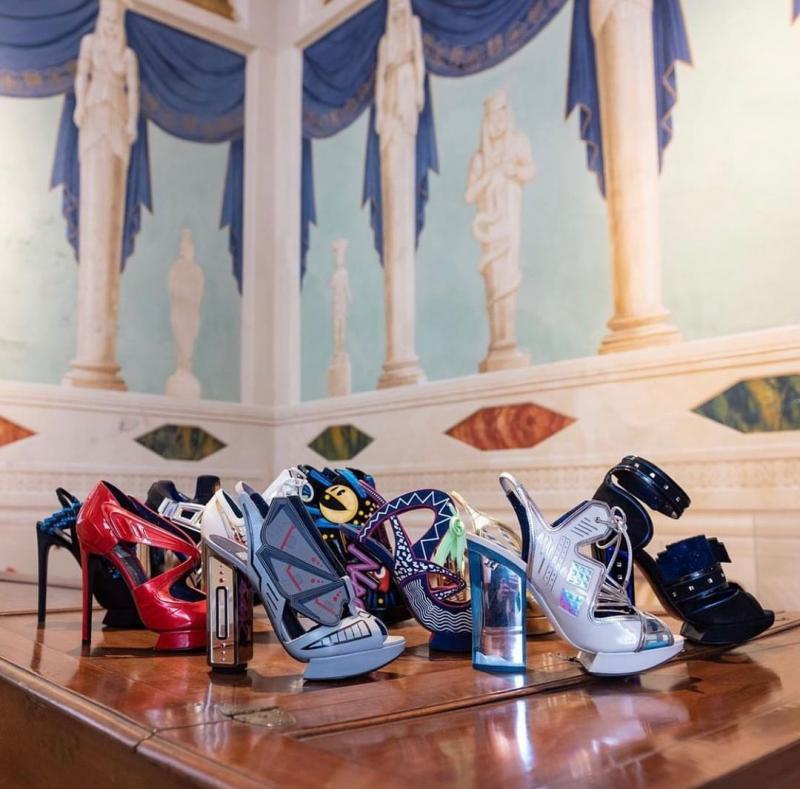When I first heard about a “Shoe Museum” in small-town Italy, I wasn’t exactly brimming with enthusiasm. “But it has a fascinating collection of women’s footwear from the 1940s to the present day!” argued its proponents. I politely replied with an “Oh, cool. But I’m not really sure that’s my thing.”
Guys and girls, sometimes in life you have to admit that your prejudices were wrong. The Museo della Calzatura (Shoe Museum) in Stra — a small town about halfway between Venice and Padova — is enthralling.
It’s a museum for people who love shoes, people who hate shoes and people who have no strong opinion on shoes. The 1400 footwear models on display are astonishing works of art, running the gamut from achingly beautiful to utterly bonkers.
How the Shoe Museum found its footing
The museum was founded in 1993 by Luigino Rossi, a cobbler who had worked with Charles Jourdan, Calvin Klein and Yves St Laurent, manufacturing their shoes at his factory in Stra. This small area is Italy’s “Footwear Valley,” home to 88 shoe factories, 31 designers and 24 commercial firms employing more than 10,000 workers, making some 20,000,000 pairs of shoes each year for clients such as LVMH, Armani and Gucci. If your designer shoe says Made in Italy somewhere on it, there’s a good chance it was made here.
The museum is housed in Villa Foscarini Rossi, a 17th-century country estate, commissioned by Venetian nobleman Jacopo Foscarini, and worked on over the years by architects such as Vincenzo Scamozzi, Francesco Contini and Giuseppe Jappelli, as well as fresco painters Domenico Bruni and Pietro Liberi. The result is typically grand and beautiful — an eclectic mix of neoclassical and renaissance influences, exquisitely sited on the banks of the Brenta river.
All this pomp creates a dandy atmosphere for an odyssey through the surreal world of high-end women’s footwear. All the big names are here — Dior, Fendi and Marc Jacobs, to name a few — and the brief seems to have been “send us your most bonkers shoe design and we’ll display it.” Here are the unbridled imaginations of some of the world’s most famous designers, manifested in shoe form and seemingly unencumbered by the usual constraints of “commercial viability” and “logic.” Indeed, it’s with these over-the-top models that you start to appreciate each designer’s artistic vision and approach.
Snowshoes to stilettos
The museum begins with an assortment of antique footwear from Venice, as well as collections from further afield, such as Native American moccasins and Innuit snowshoes. We then move on to some of the pioneering designer women’s shoes from the 1940s and 50s, including works by Charles Jourdan and Roger Vivier, the latter credited with the invention of the stiletto heel.
“I think one of the most important shoes in the collection are the Yves Saint Laurent boots from 1968,” said Roberta Di Dia, Head of Education at the museum. “These were some of the first fashion boots designed for women, at a time when it was all flats and heels. It was a revolution for us.”
While some shoes aim for a ghost-like minimalism, others flaunt themselves like tropical birds. Some are marvels of engineering, some of imagination, some of beauty and some are downright creepy. A cavalcade of footwear curiosities, in other words: at turns beautiful, insane, punky, gothic, cheeky, terrifying and bewildering, but never boring.
One model in particular catches my eye: It’s an elegant black shoe whose straps seem to float above the insole on wisps of nylon. This is Salvatore Ferragamo’s “invisible shoe,” designed in 1947. When worn, it gives the impression of a bare foot, something which was considered scandalous in its day and contributed to its poor sales. Nonetheless, it won Ferragamo the now-defunct Neiman Marcus Award (the onetime “fashion world Oscar”), becoming the first shoe designer to be honored. Even today, the invisible shoe feels radical and contemporary.
“My personal favorite is the suspended sandal by Fendi,” Di Dia continued, pointing out a small, floral high heel shoe — with no heel and minimal base support. “It’s a challenge to walk in them as you can imagine. But they’re so beautiful that you work through the pain.”
Sure. But had she tried them?
“Yes,” she beamed. “One of the perks of the job.”
Moving from the sublime to the sublimely ridiculous, there is a Celine high heel with a nut bolt for a toe hold that looks like the world’s most fashionable torture device. Another Celine high heel with painted toenails is surreally positioned on a piano keyboard, like a leftover prop from a Luis Buñuel film. In fact, Buñuel does make a cameo appearance of sorts — the YSL-designed shoes that Catherine Deneuve wore for his film Belle de Jour are on display here. There are high heels with no straps, high heels which are only straps and Kenzo shoes with kaleidoscopic color patterns that seem designed to induce a kind of blissful trance. Marc Jacobs crashes in at one point with some mouse-faced high heels; a pair of Emilo Pucci pumps looks as if they’ve been fashioned out of a coral reef; and a wicker-weaved shoe by Marc Bohan from 1967 is unfathomably elegant.
Slowly my taciturn acceptance flowered into genuine delight. It’s partially the approach of curating shoes like pictures in an art gallery that makes the museum so appealing, along with the emphasis on spectacle, eccentricity and beauty.
But there’s also something genuinely joyous about seeing human creativity in all its artistic and technical variety expressed through the unlikely medium of women’s shoes, each one as unique as a poem. And yes, there’s even a sense of humor here, something that is perhaps missing from the more commercially designed models. This last category comes courtesy of Nicholas Kirkwood, who has cooked up an assortment of 1980s-themed nostalgia high heels, including a Pac-Man stiletto that catwalks a fine line between transcendent and cringe.
Take it from a shoe skeptic — this museum is worth it.
If you go
Museo della Calzatura (Shoe Museum) at Villa Foscarini Rossi
Via Doge Pisani 1/2
30039 Stra, VE
Tel. +39 049 9801091









